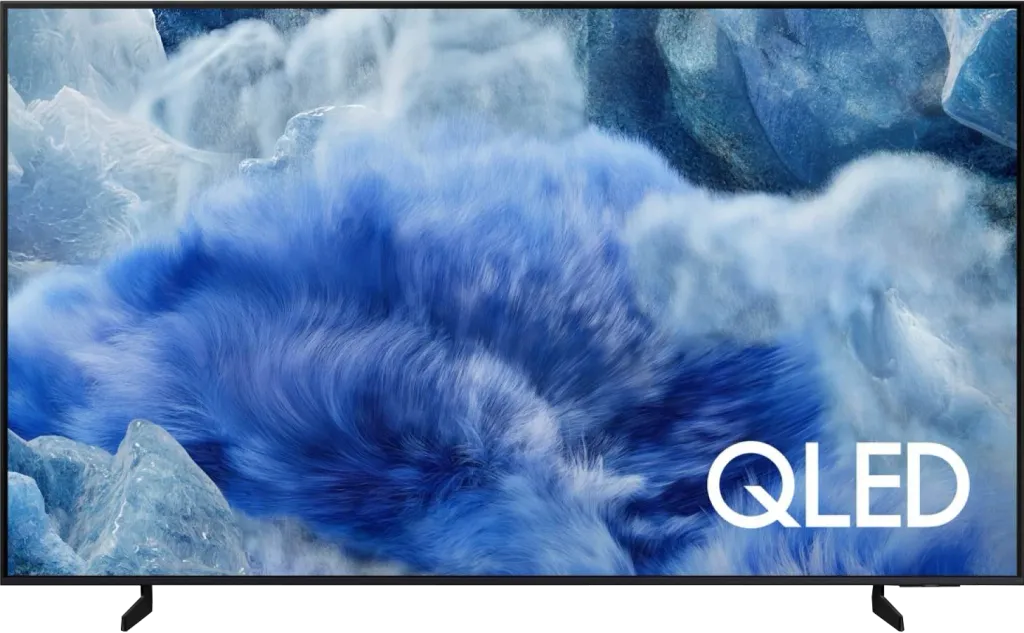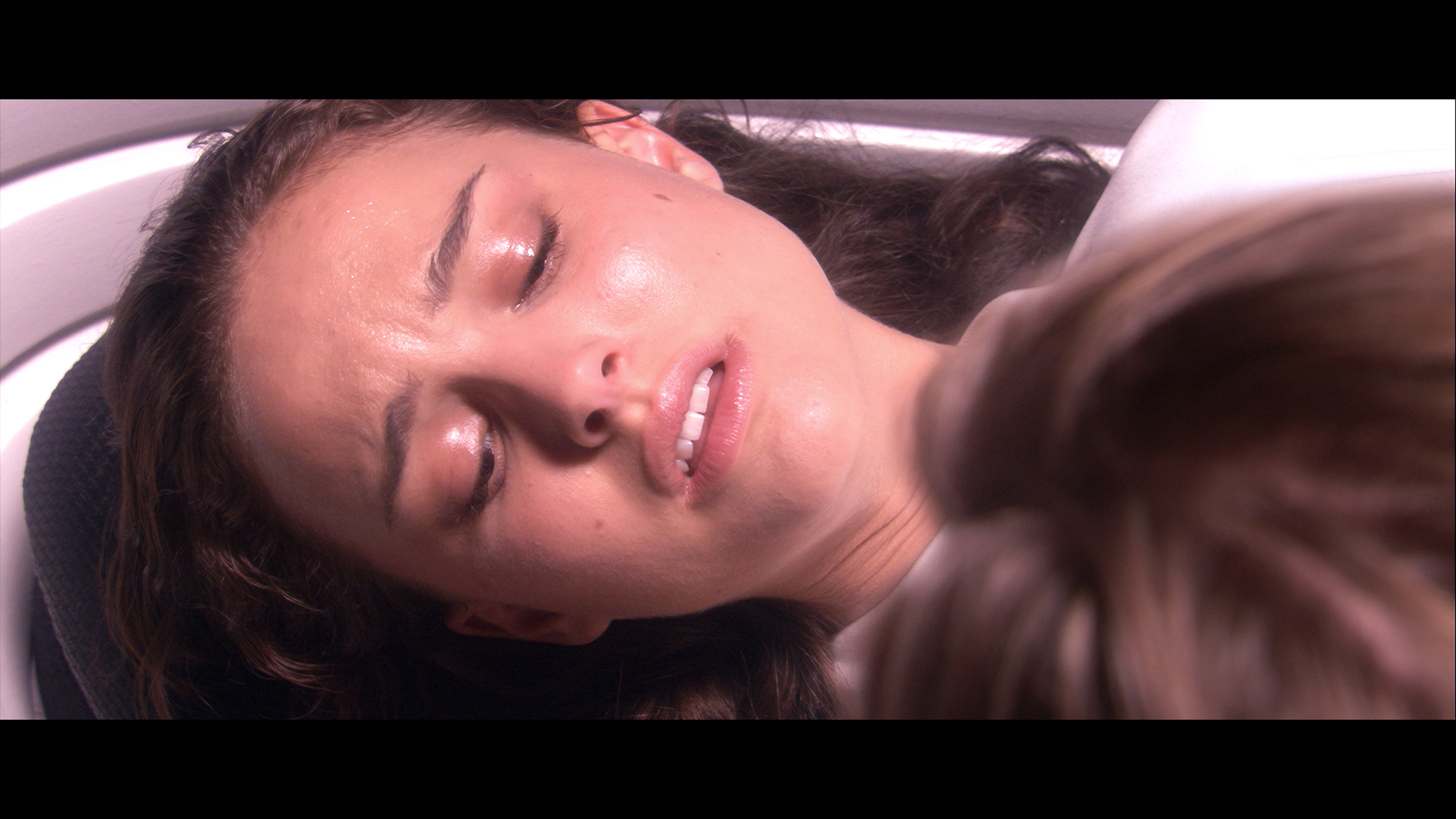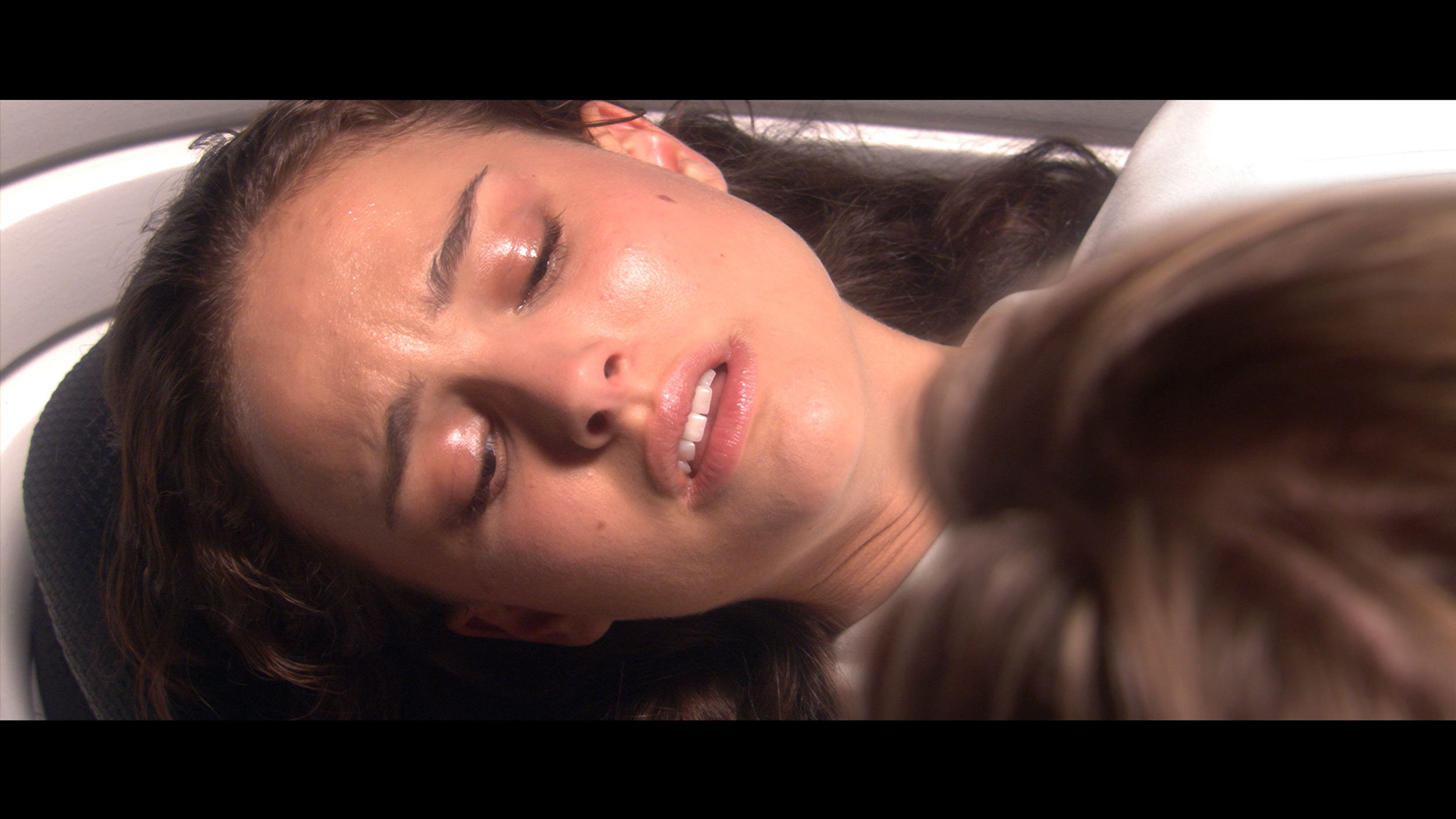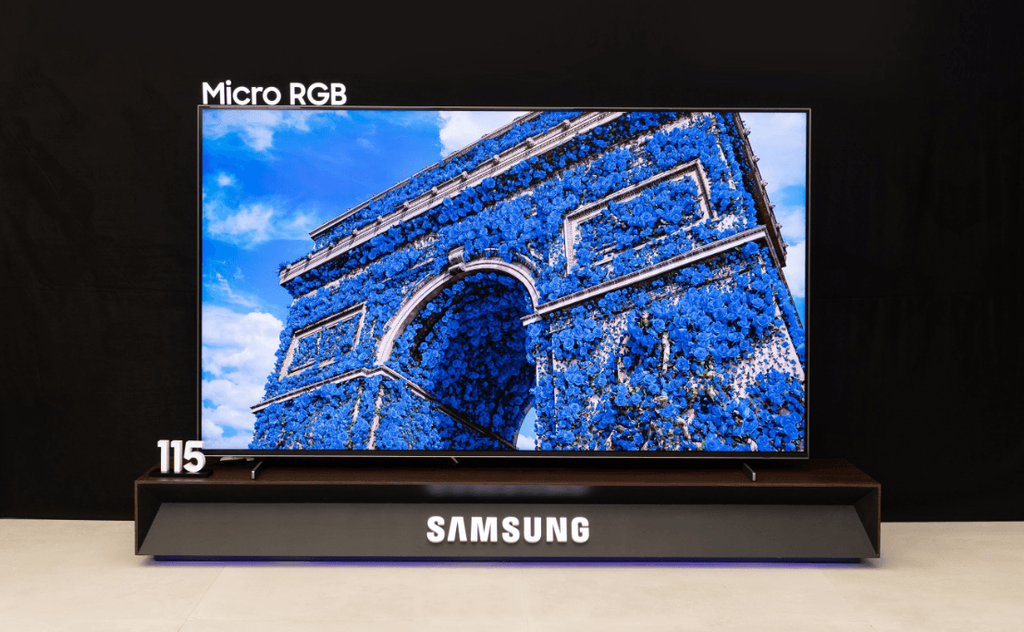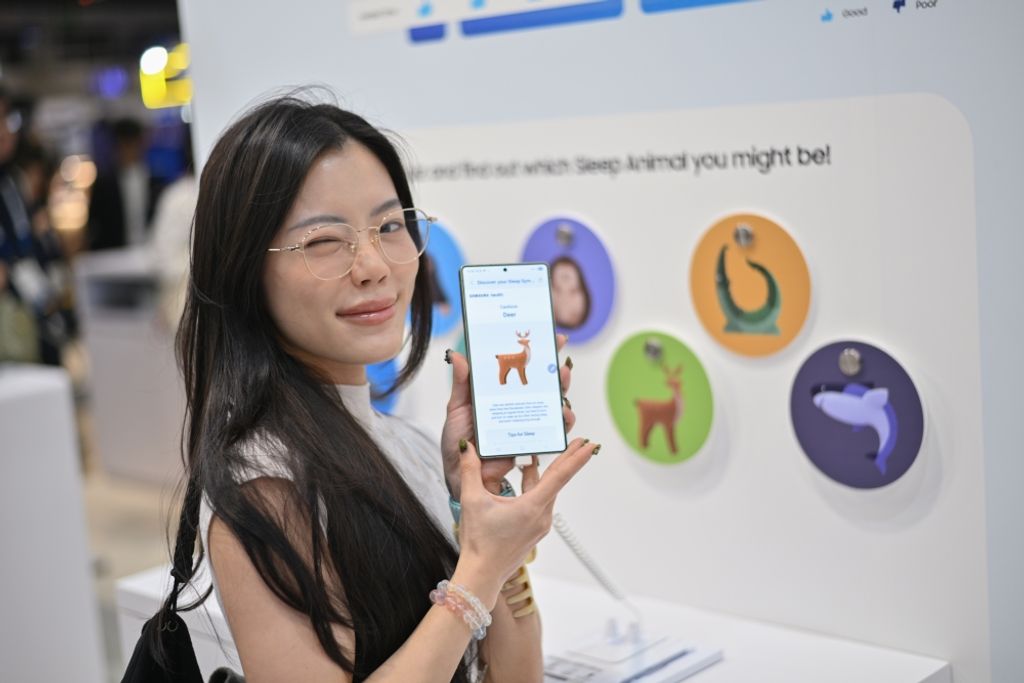- Matching (Score)
- Our verdict
- Competing TVs
- TV appearance
- Where to buy
- Contrast and black detail
- HDR effect quality
- Factory color reproduction
- Color reproduction after calibration
- Smoothness of tonal transitions
- Image scaling and smoothness of tonal transitions
- Blur and motion smoothness
- Console compatibility and gaming features
- Input lag
- Compatibility with PC
- Viewing angles
- TV efficiency during daytime
- TV features
- Apps
- Playing files from USB
- Sound
- Details about the matrix
Panel type: LCD VA Refresh rate: 60Hz Brand: SAMSUNG Resolution: 3840x2160 System: Tizen Model year: 2025
Samsung Q8F is the top representative of the QLED series for 2025. The Koreans have mixed things up in the naming, so at first glance, it's easy to confuse it with the Q80 series of televisions. In reality, however, we are dealing with a continuation of the well-received Q60D line from last year. What improvements and surprises has the manufacturer prepared? Is the Q8F just a facelift of the old model, or could it be something that truly transforms everyday viewing of movies and series?
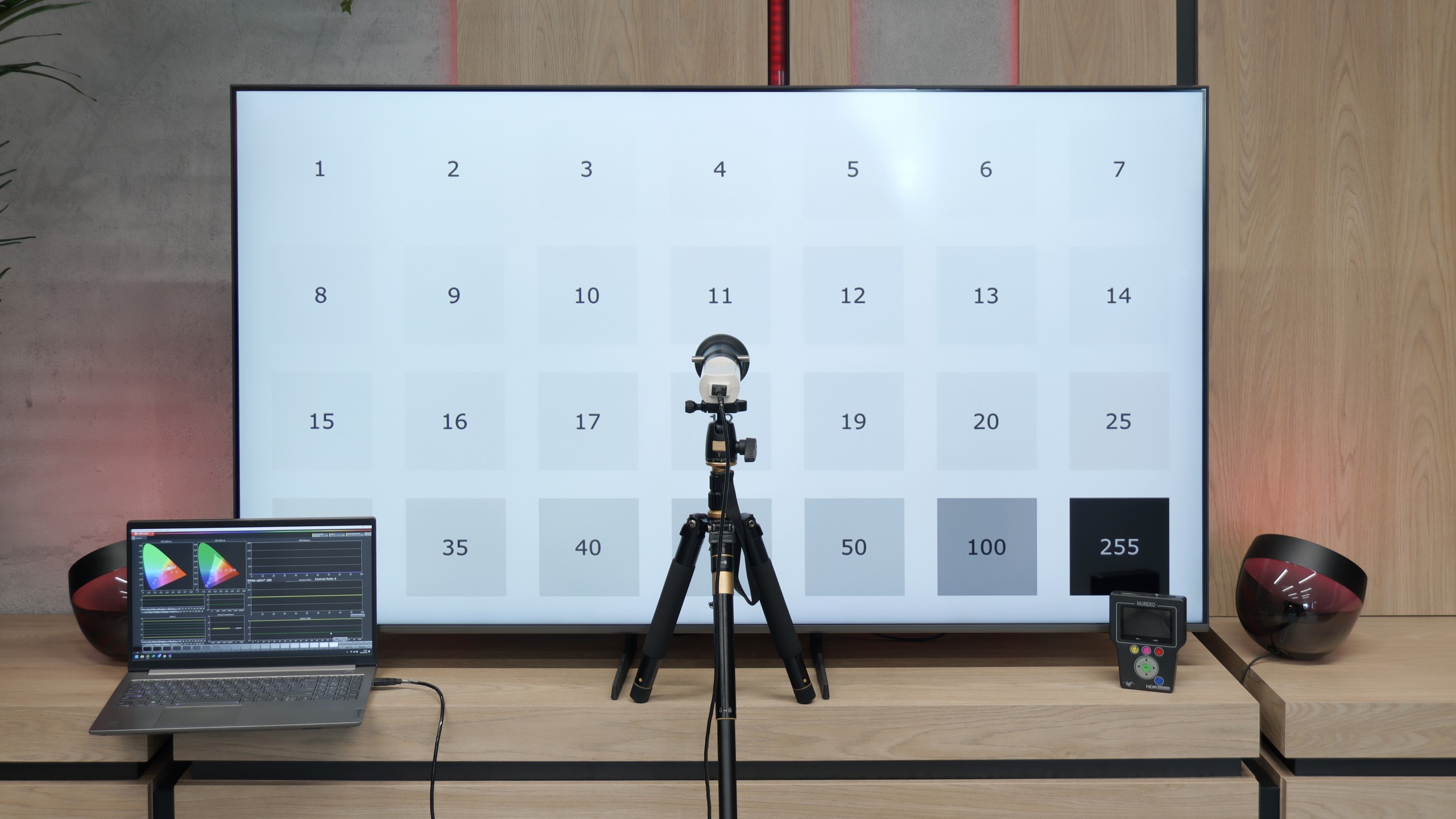
SAMSUNG Q8F - Our verdict
6.3
Overall rating
Samsung Q8F is quite a successful continuation of the Q67D model. It offers similar image quality in HDR content, and with a brightness of around 500 nits, it creates an effect that is hard to call ordinary. The support for the HDR10+ format also helps, which has been competing with Dolby Vision for some time and provides comparable experiences in many productions. The contrast is another plus – for a VA panel, it holds up well and allows for enjoyable blacks in movies and series. However, the biggest asset of the Q8F remains its operating system. Tizen runs quickly, provides access to many applications, and works well with the SmartThings ecosystem, so the TV can easily be integrated into a larger network of home devices. Interestingly, the Q8F also has a niche use – thanks to very good font readability, it works excellently as a screen for text work. Additionally, the adjustable stand allows the TV to be placed on virtually any desk or in a narrower TV cabinet. The biggest drawback, in our opinion, is not the image quality itself – as it's hard to expect miracles in this price class – but rather what has happened to the features for gamers. Due to updates, options such as VRR and HGiG, which were available even in simpler constructions in previous generations, have disappeared. In fact, the manufacturer even boasts about the availability of these features in their catalogue. This makes it hard to recommend the Q8F to anyone planning to connect a console and counting on full support for new technologies. Therefore, the Q8F is a TV that can appeal – primarily due to its design, above-average image quality, and efficient Tizen system. But at the same time, a step backward compared to its predecessor is evident. Let's hope Samsung can quickly rectify these shortcomings, as otherwise, even such a successful “everyday” TV may leave some users feeling unsatisfied.
Advantages
Solid contrast thanks to the VA panel
Pretty good brightness in SDR and HDR (up to about 500 nits)
Satin finish does well with reflections
Tizen operating system – fast, intuitive, with a rich app selection
Solar remote with USB-C charging
Integration with the SmartThings ecosystem
Great input lag
Good font readability when working with a PC, suitable as a text work monitor
Adjustable stand on multiple planes
Disadvantages
Severely limited features for gamers (no VRR in practice, no HGiG)*,
No USB recording or PiP functionality
Average digital image processing
*We hope that the promises on the promotional brochures will be quickly fulfilled through software updates.
Movies and series in UHD quality
6.3
Classic TV, YouTube
6.0
Sports broadcasts (TV and apps)
5.6
Gaming on console
7.0
TV as a computer monitor
6.0
Watching in bright light
5.6
Utility functions
7.3
Apps
8.7
Sound quality
6.0
Complete the survey to find out what fits your preferences
SAMSUNG Q8F - Competing TVs in this price range
SAMSUNG Q8F - TV appearance
HDMI inputs: 3 x HDMI 2.0, 0 x HDMI 2.1 Outputs: Toslink (Optical audio), eARC (HDMI), ARC (HDMI) Network Interfaces: Wi-Fi 2.4GHz, Wi-Fi 5GHz, Ethernet (LAN) 100Mbps
Build quality: BuildQuality-Good
Stand type: Legs
Bezel colour: Graphite
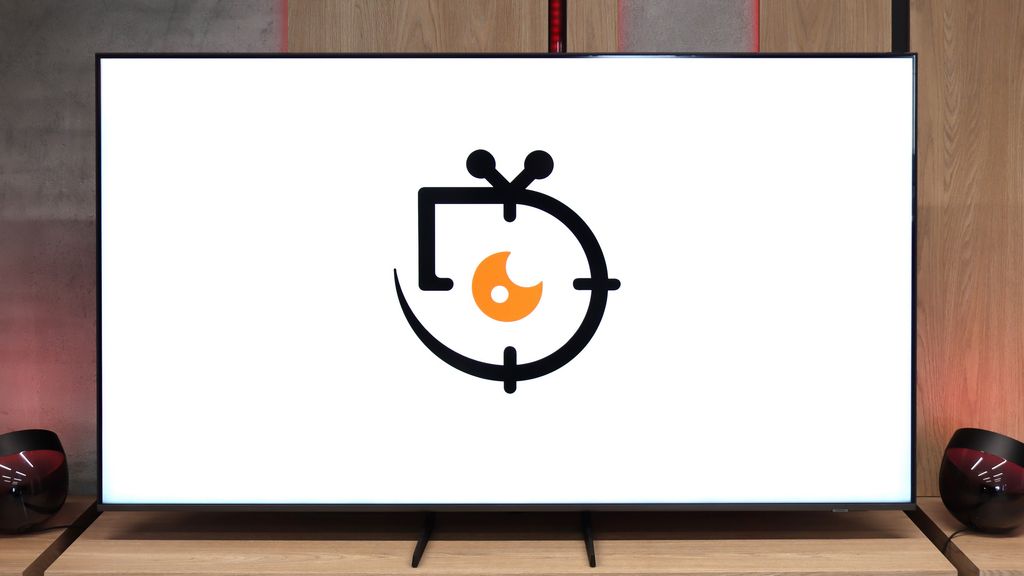
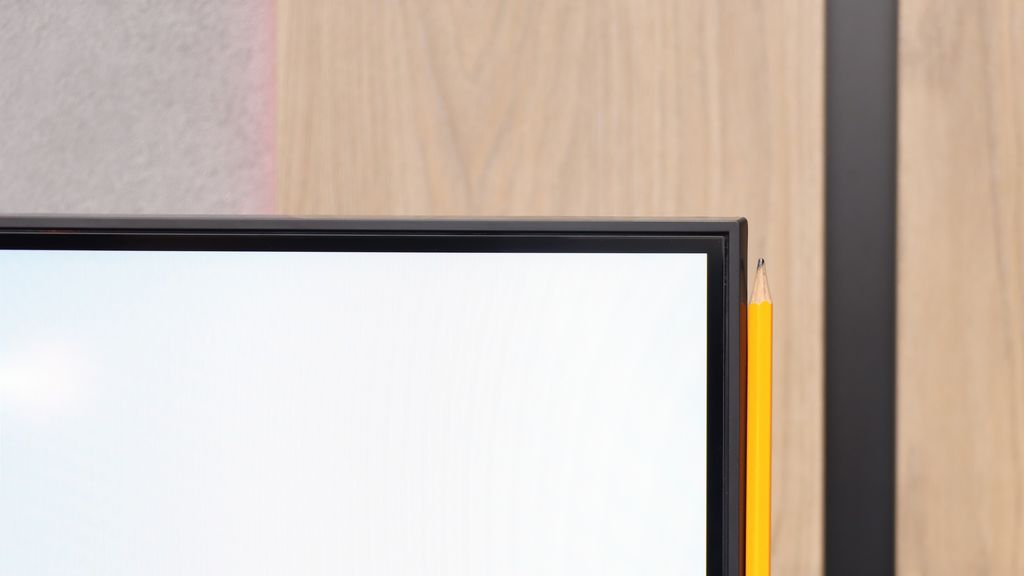
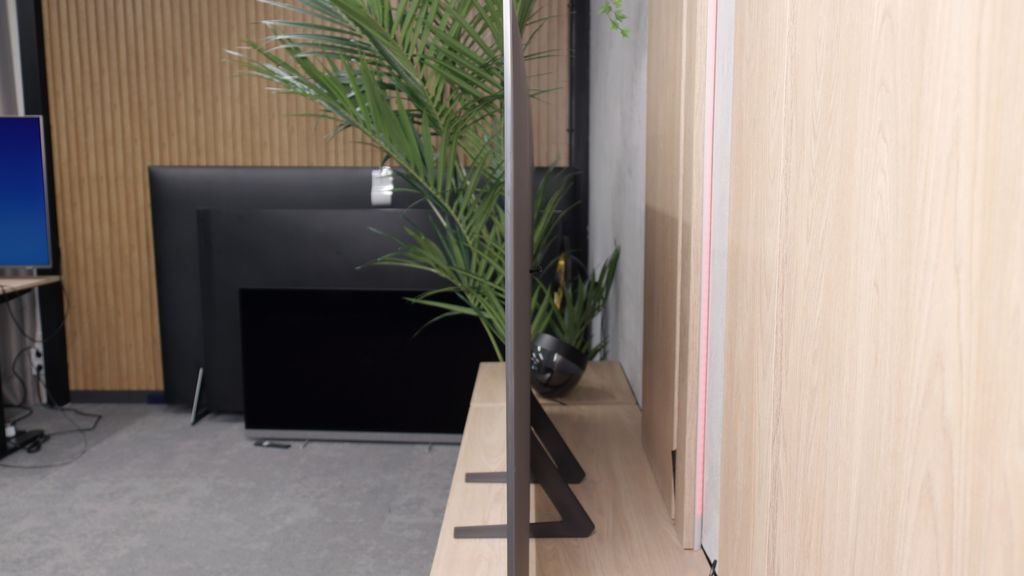
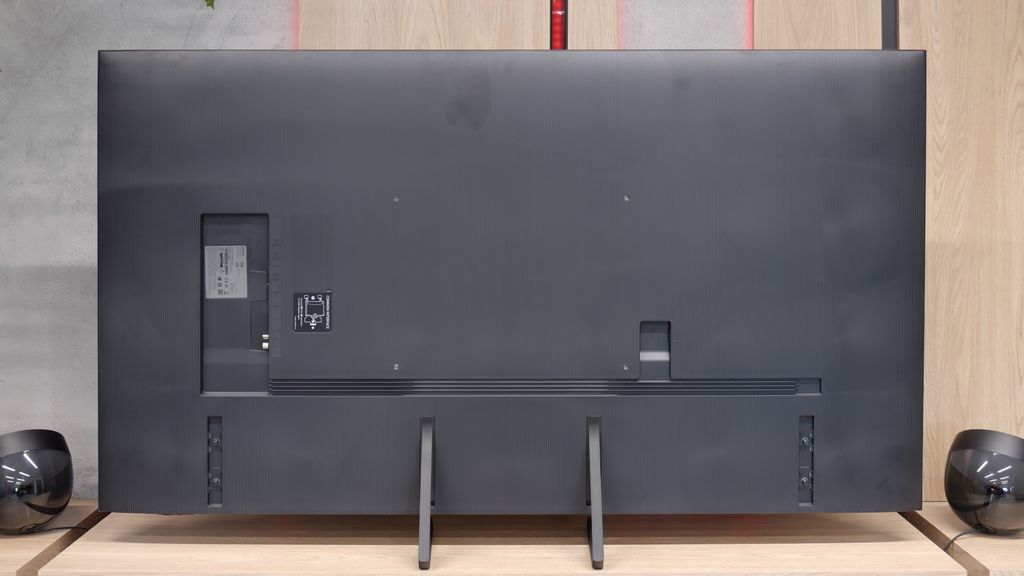
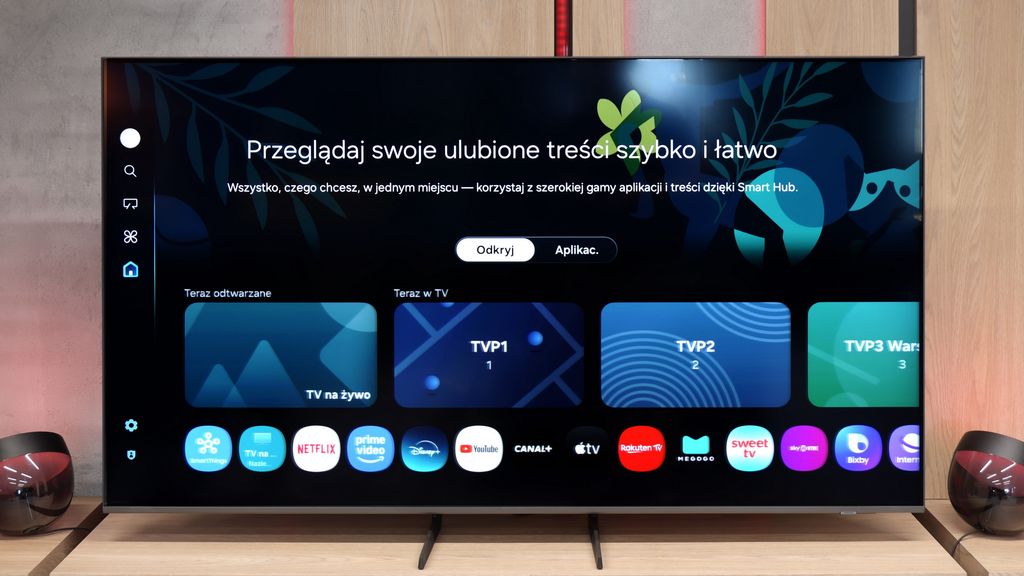
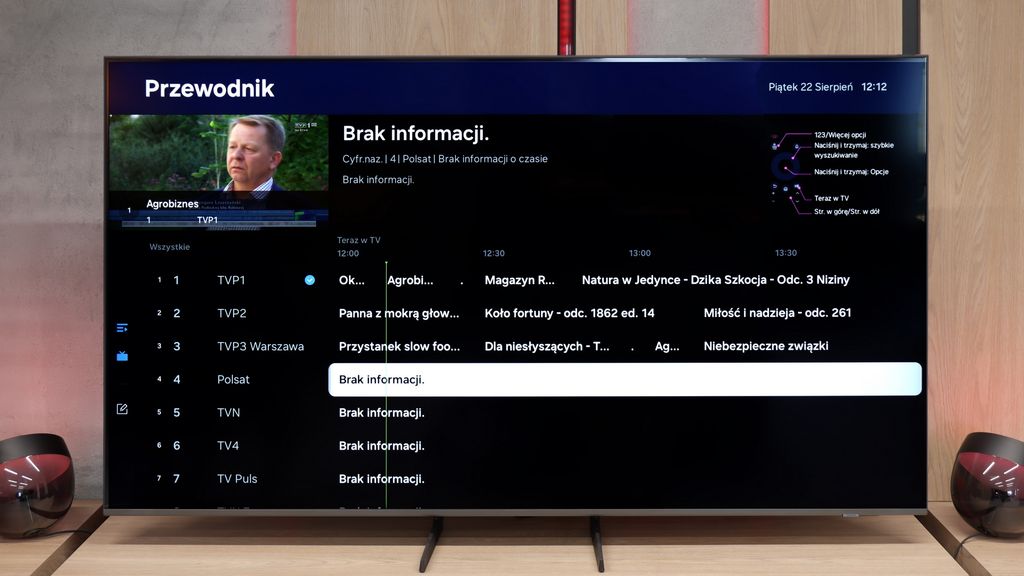
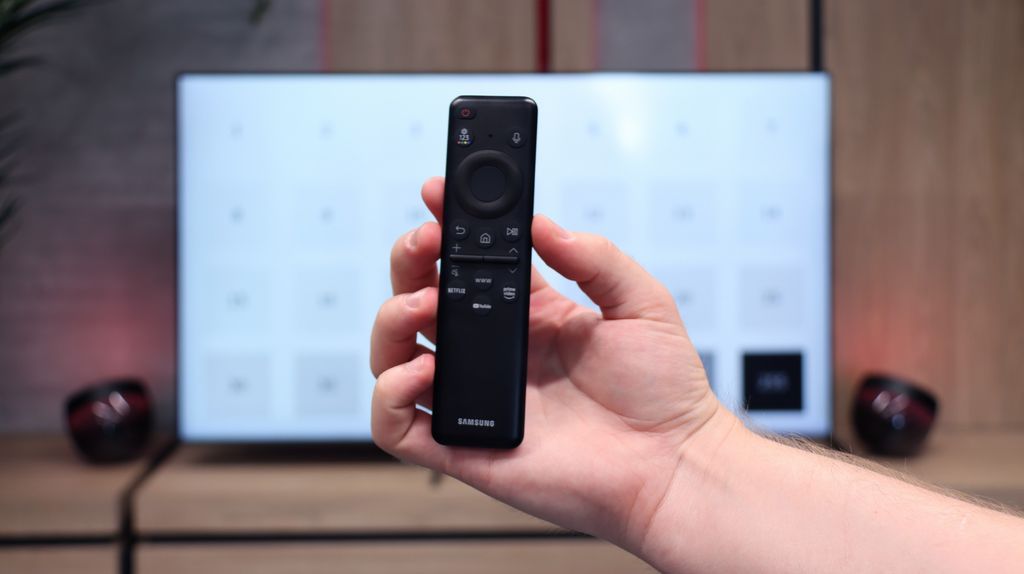
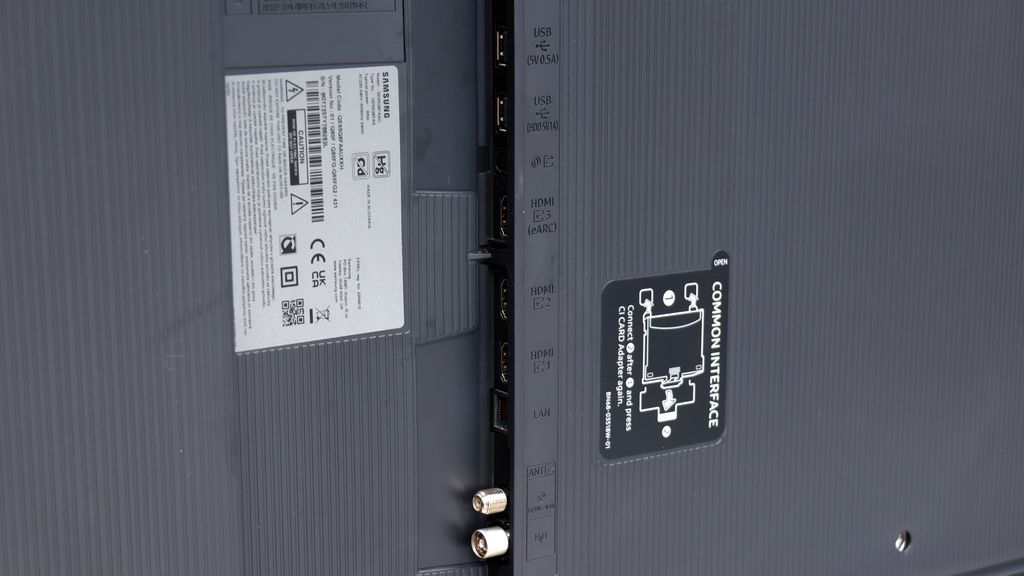
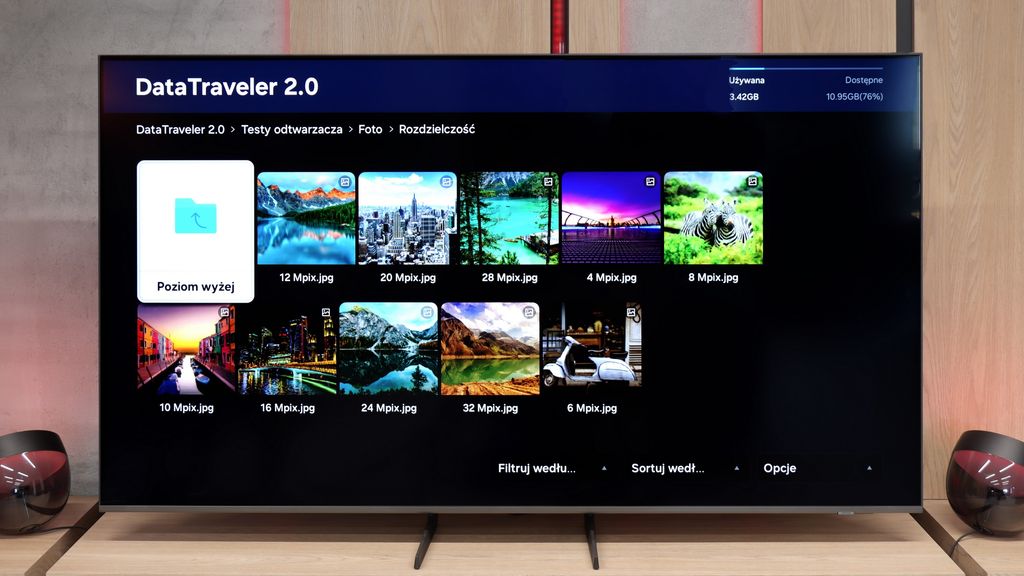
Stand: Height adjustment, Base adjustment
Flat design: Yes
Accessories: Stand
Looking at the Samsung Q8F, it's hard not to get the impression that it's almost a twin of last year's Q60D. The TV immediately makes a good impression — and not just because Samsung has been focusing on aesthetics as the first point of contact with customers for years. For a model in this price range, the build quality is really solid. The bezels are indeed plastic, but they are sleek and give the entire unit a lightness. The design itself is very slim, which means that when the TV is mounted on the wall, it looks almost like a picture. However, if someone prefers a classic stand, there is a useful solution here: the legs can be mounted in different positions — wider or closer together, which will be appreciated by owners of narrower cabinets. What's more, their height can also be adjusted, allowing for a soundbar to be neatly tucked under the screen without the risk of obstructing the image. The whole thing looks tidy and solid, giving the impression of a thoughtfully designed product.
Buy in the best price
Select size:
SAMSUNG Q8F - Contrast and black detail
5.5/10
Local dimming function: No

Result
5,200:1

Result
4,650:1

Result
3,650:1

Result
4,100:1

Result
4,150:1
Visibility of details in the lights:
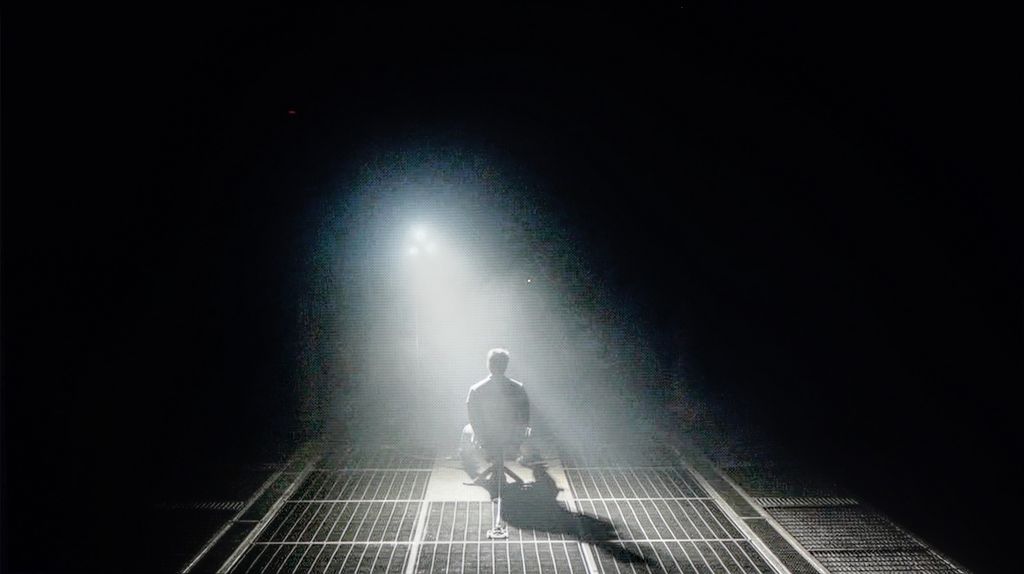
Samsung Q8F uses a VA LCD panel, which immediately puts it in a good position regarding contrast. By nature, such panels offer deeper blacks than IPS panels, and you can actually see this effect here. On test patterns, the contrast ranged from about 4000:1 to even 6000:1, which practically results in a surprisingly engaging image, especially in a slightly dimmed living room. Of course, this is not the level of LCD screens with local dimming, let alone OLED — sometimes the blacks can verge on a shade of navy, and the overall image can appear flat. However, Samsung employs a simple trick: so-called global dimming, which dims the entire screen when there are many dark sections. The effect can be impressive, but it comes at the cost of losing some details, which may not appeal to everyone. Nevertheless, the Q8F still performs significantly better than televisions with IPS panels, offering solid contrast and blacks that can immerse you in the cinematic atmosphere.
Halo effect and black detail visibility:
SAMSUNG Q8F - HDR effect quality
5.2/10
Supported formats: HDR10, HDR10+, HLG Color gamut coverage: DCI P3: 90.7%, Bt.2020: 66.2%
Luminance measurements in HDR:

Result
473 nit

Result
417 nit

Result
457 nit

Result
210 nit

Result
471 nit
In terms of brightness, the Samsung Q8F performs surprisingly well for a TV without local dimming. It measures up to 500 nits, which in practice means that most movie and series scenes look pleasant, and it cannot be faulted for lacking the "HDR effect." In films like Life of Pi or The Meg, the screen can burst with bright light, delivering a level of lighting effect that is satisfying. It struggles more in challenging moments—such as dark scenes with single bright points. The global dimming used causes the TV to darken the image to maintain deep blacks, but at the expense of detail brightness. This is clearly visible in the scene from Sicario 2, where the brightness of the helicopter lights dropped to around 200 nits. This is a deliberate design choice that gives the impression of deeper blacks but takes some shine away from individual elements, and one should simply keep that in mind. Regarding colour reproduction, the Q8F uses quantum dot technology, which expands the colour gamut. A coverage of the DCI-P3 palette at 91% can be considered a decent result, although it is not a record-breaking figure compared to other QLEDs.
Scene from the movie “Pan” (about 2800 nits)
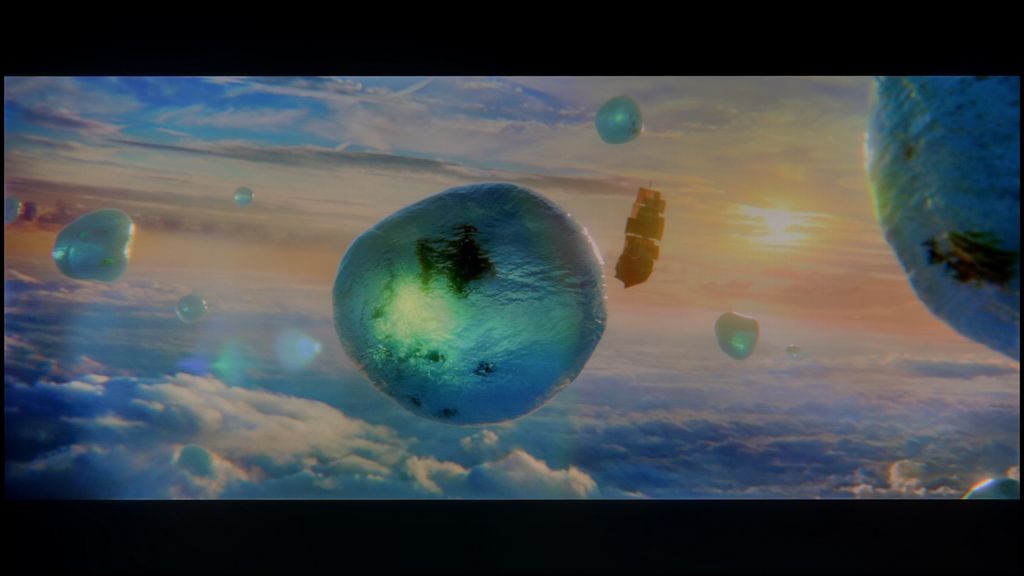
Scene from the movie “Billy Lynn” (about 1100 nits)

Of course, we didn't just stop at measurements — we also checked how the Q8F performs in practice during viewing sessions. We tested both demanding productions like Pan and Billy Lynn, as well as a few more everyday titles. To our surprise, the television performed really well. The brightness doesn't match top-tier screens, but the image still managed to capture attention. The fireworks in Billy Lynn didn't blend into a single blob of light, and the sunset in Pan looked cohesive and natural. Admittedly, there are some colour deficiencies compared to reference displays, but in this price range, it's hard to consider that a serious drawback. A significant contribution came from the dynamic tone mapping feature, which we left switched on this time, unlike other Samsung models. Thanks to it, the Q8F managed to recover a lot of details in difficult scenes without artificially brightening the entire image.
HDR luminance chart:
HDR luminance
Movies that we tested earlier were recorded in standard HDR10, so those observations pertained to that format. And while HDR10 on the Q8F delivers a pleasant effect, it's clear that in the brightest scenes, full of details, classic tone mapping can be insufficient. That's when HDR10+ comes into play — a dynamic format, increasingly present on platforms like Netflix, Amazon Prime, and Apple TV. It's thanks to this that the image gains an extra dose of detail and looks fuller than in static HDR. It's a shame that Dolby Vision is missing, which is more widespread, but considering the growing importance of HDR10+, it's hard to treat this absence as a serious flaw. One could even suspect that in the near future, most content will be available in versions with Samsung's dynamic metadata anyway. At least we hope so.
Static HDR10

Dynamic: HDR10+

Factory color reproduction
4.6/10
We decided to check out the Filmmaker mode because right out of the box it gave us the best picture. However, that doesn't mean it was perfect. The white balance had too much of a blue and red tint, causing the whites to lean towards a slight purple-pink hue. Such imbalance affected the visibility of virtually all colours, which is clearly seen in the comparison photo below. The brightness characteristics in SDR content were quite well calibrated, although in HDR materials we noticed that the TV didn't always handle its global dimming well — at times the screen was too dim, while at other times it could suddenly brighten up. Fortunately, issues related to colours can be effectively corrected with calibration tools, so we decided to get to work.
Color reproduction after calibration
7.8/10
After calibration, we managed to correct the white balance to almost perfection. Older SDR content looks fantastic — most errors are within a value of 2, which is definitely below the threshold of human perceptibility. In HDR, we also brought the white balance to an acceptable level, but a different problem arises here. So why are there still relatively large errors in colour reproduction? This is mainly due to the limited colour palette and the way the television manages brightness. The global dimming technique used does not give the user control in the settings, so analysing the EOTF curve in HDR films, it's clear that the Q8F can modify luminance on its own. This can be seen as a limitation, but still, the image after calibration is much more enjoyable to watch than in the factory version.


SAMSUNG Q8F - Smoothness of tonal transitions
9/10
The fluidity of tonal transitions in the Q8F performs really well. The television beautifully blends colours, both in bright segments of the sky and in darker scenes, where visible "steps" in colour can easily occur. Admittedly, sporadic errors do happen, but you have to look closely to catch them. In practice, while watching movies or series, the picture looks cohesive and doesn’t get distracted by any artefacts. Therefore, the rating in this category had to be high. 😉
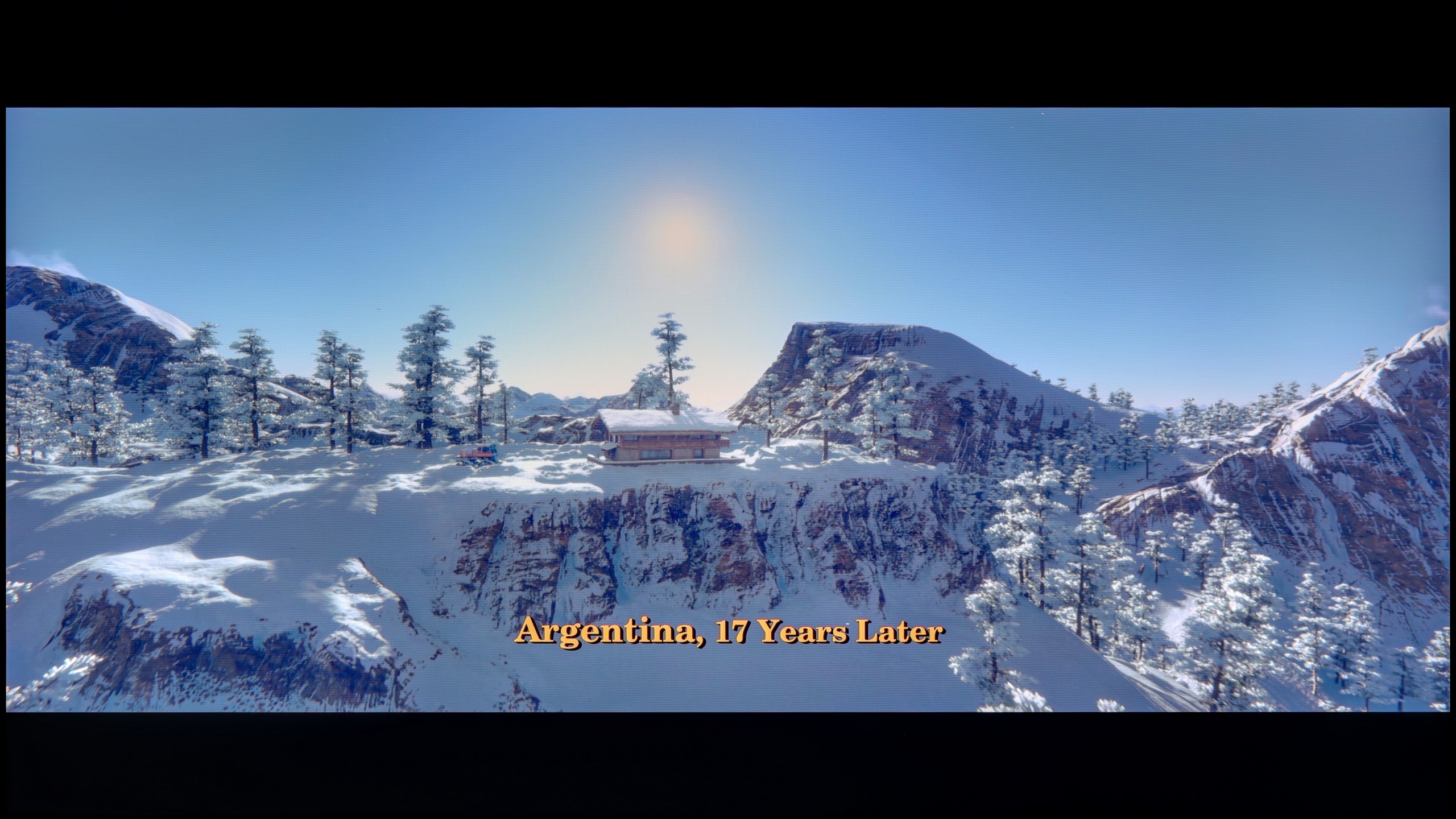

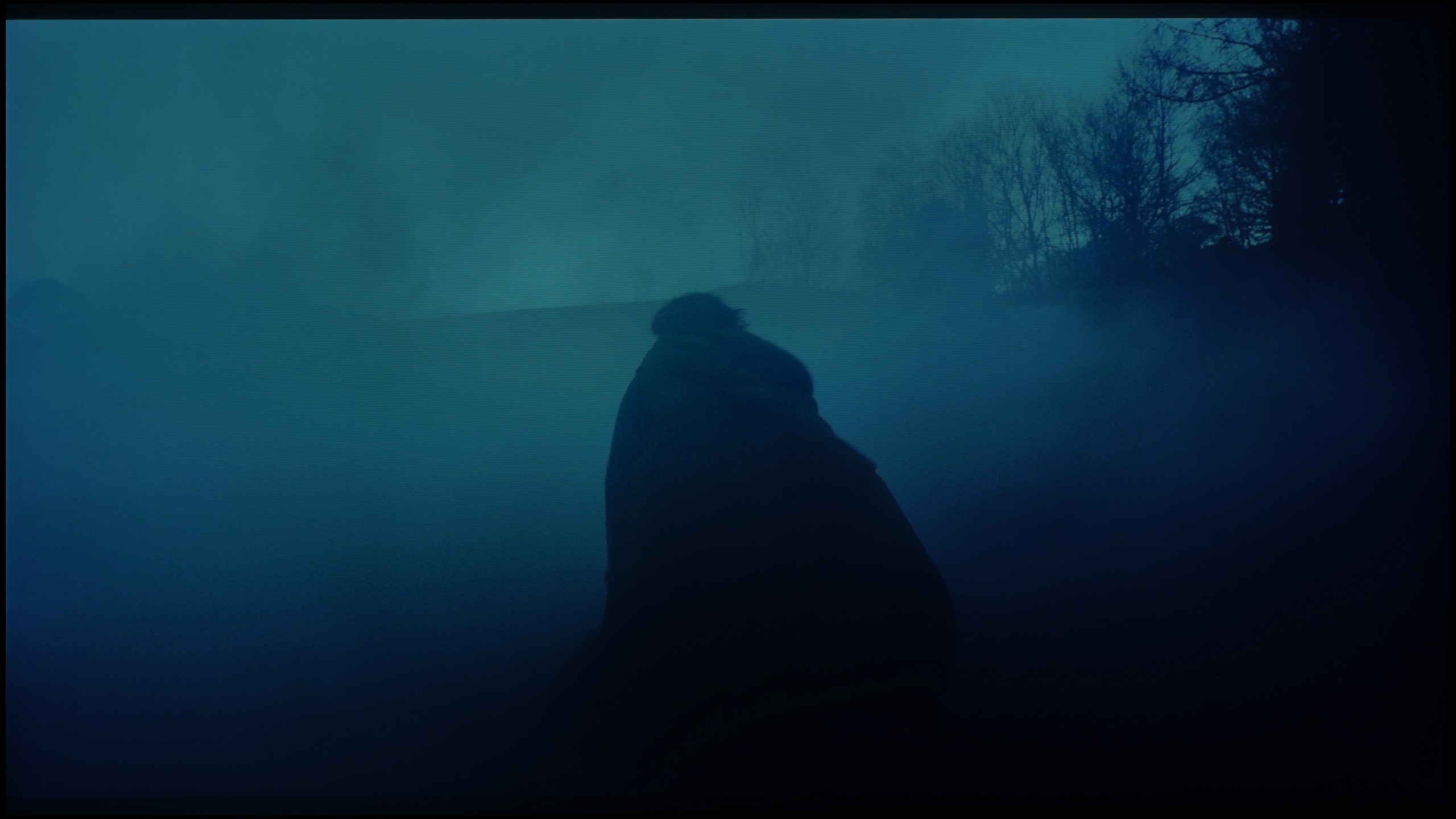





Image scaling and smoothness of tonal transitions
5/10
Smooth transition function
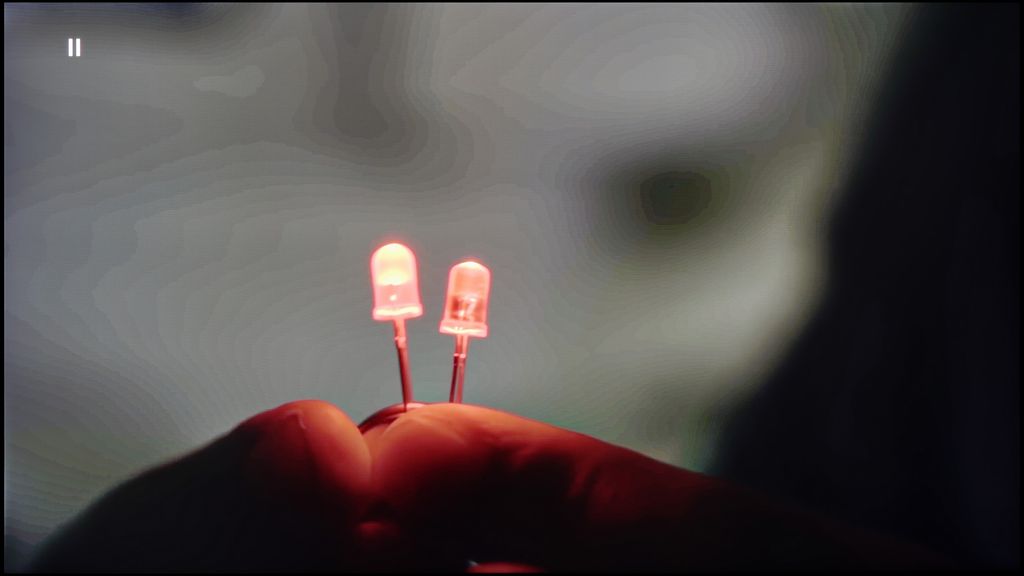
Image without overscan on the SD signal

Let's see how the Q8F handles older content, which often has poor quality. Starting with the positives: the upscaling works really well. The TV performs nicely with both classic television and materials from YouTube, not giving the impression that we're dealing with something completely unattractive. It struggles more with content in very low resolutions, such as 576p — the image can be cropped, and unfortunately, the overscan phenomenon cannot be disabled. Moreover, the digital processing does not look great either. The noise reduction feature, instead of removing unwanted artefacts, smooths out almost everything: film grain (which many viewers desire) disappears along with the texture of the image, and actors' faces start to resemble characters from cheap Turkish soap operas. It's hard to consider this option useful — it's best left completely off. Perhaps Samsung will refine the function’s performance in updates, but for now, it’s difficult to view it as anything other than an unnecessary addition.
SAMSUNG Q8F - Blur and motion smoothness
5.7/10
Maximum refresh rate of the panel: 60Hz
Film motion smoothing option: Yes
Blur reduction option: No
BFI function 60Hz: Yes, 120Hz (double contours)
Brightness drop with BFI: 50%
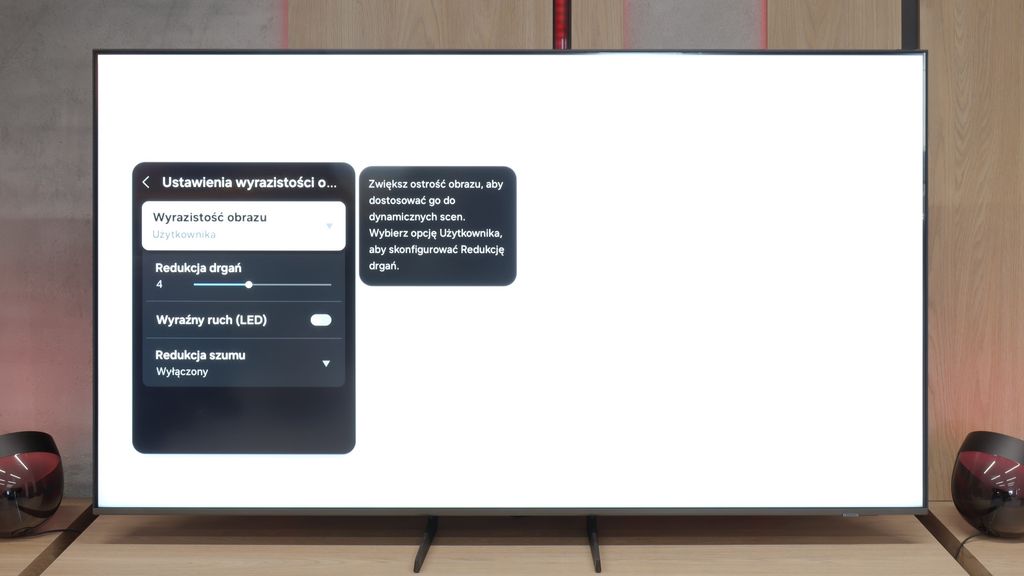
Due to the applied 60 Hz panel, it's hard to call the Q8F a television made for gaming or watching sports. The panel isn't particularly fast, making motion blur clearly visible. If you were expecting a spectacular, almost 'stadium-like' experience during broadcasts, you might feel a bit disappointed. Fortunately, for movies and series, Samsung hasn't given up on the motion smoothing function. It's nothing more than a smoother that allows for improved fluidity of productions recorded at 24 or 30 frames per second. This way, you can decide for yourself whether you prefer a more fluid, 'television-like' image or to retain the cinematic character. It all depends on the viewer's preferences, and the ability to adjust this parameter is undoubtedly a plus.
Blur (native resolution, maximum refresh rate):

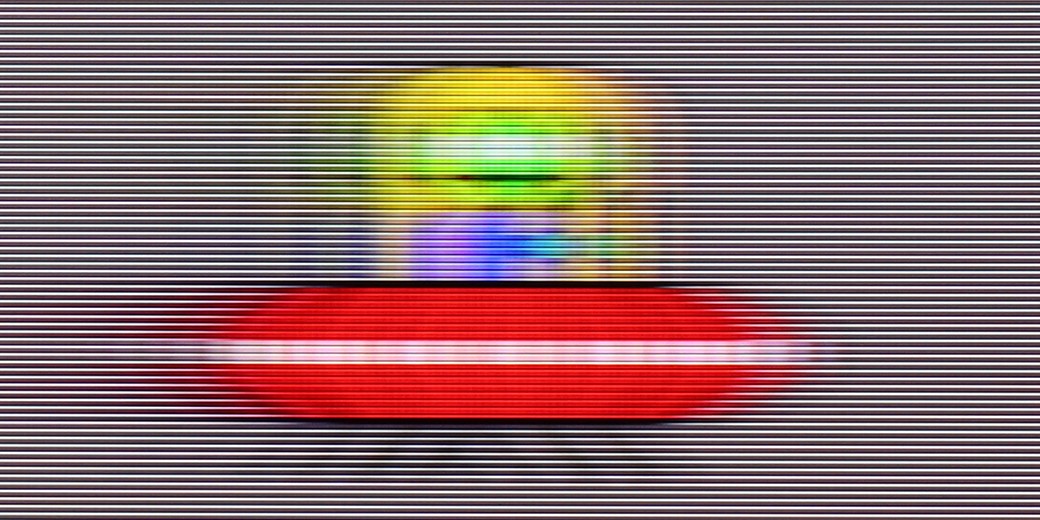
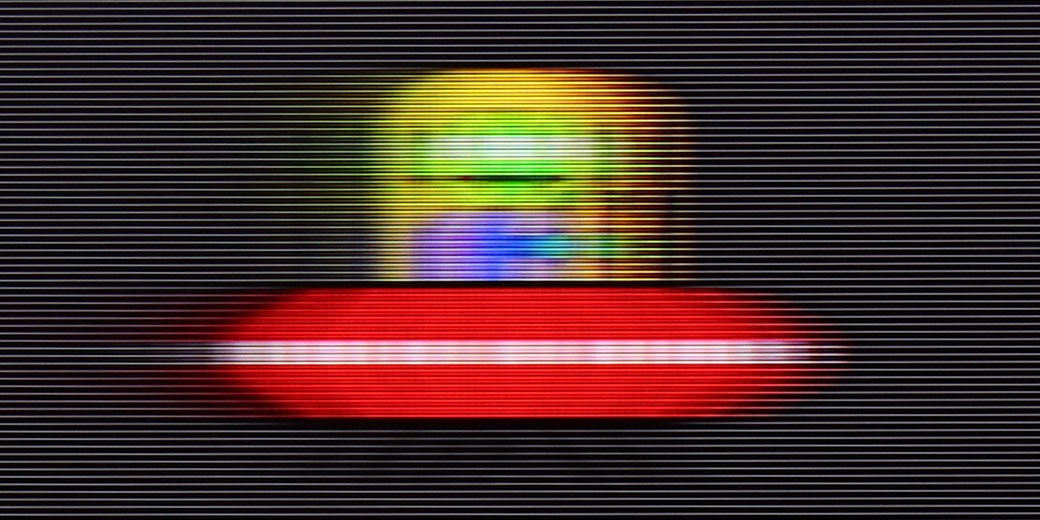
Blur (BFI function enabled):



SAMSUNG Q8F - Console compatibility and gaming features
3.7/10
ALLM: Yes
VRR: No
VRR range: No
Dolby Vision Game Mode: No
Correct implementation of HGIG: No
1080p@120Hz: No
1440p@120Hz: No
4K@120Hz: No
Game bar: Yes
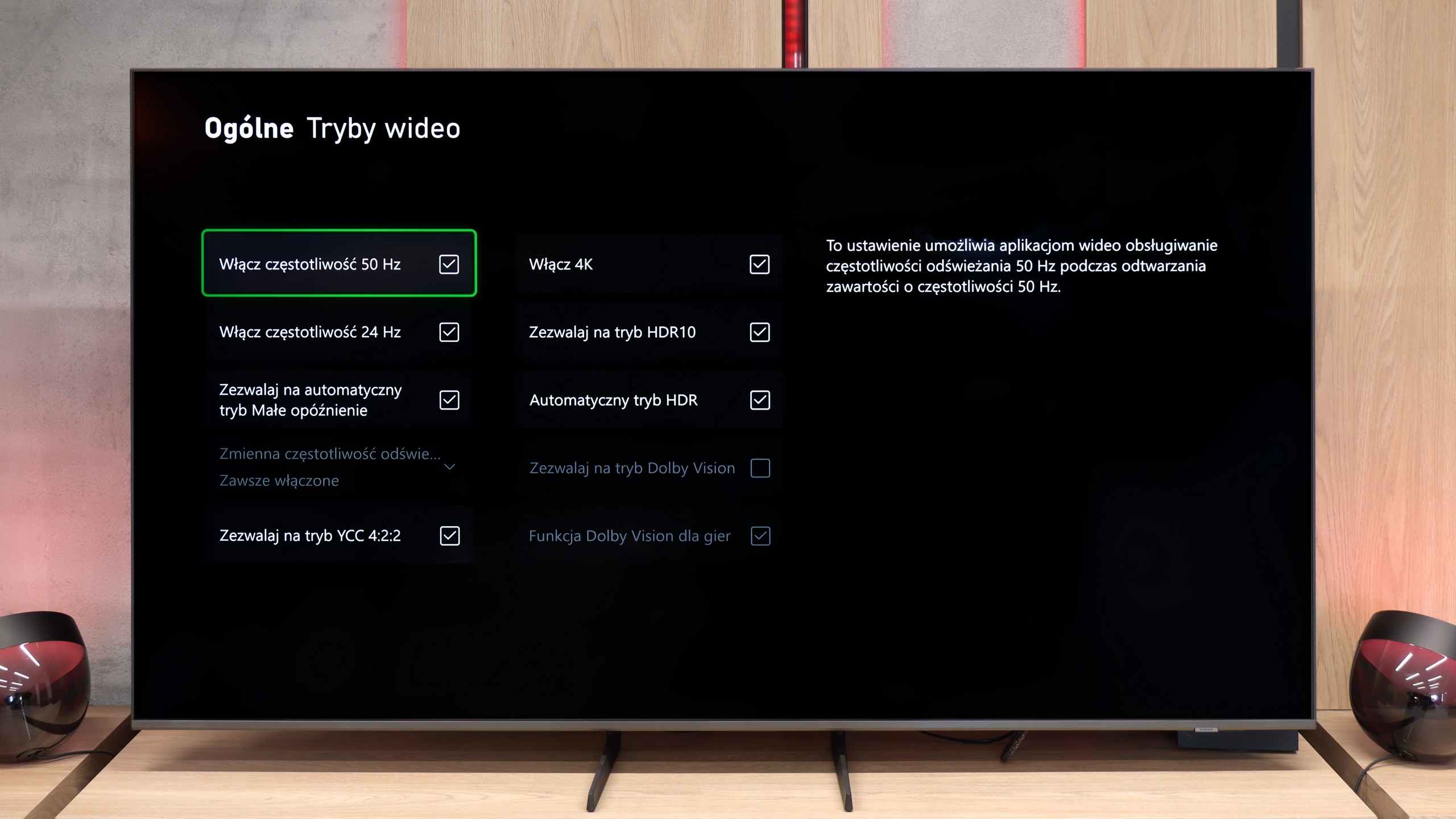
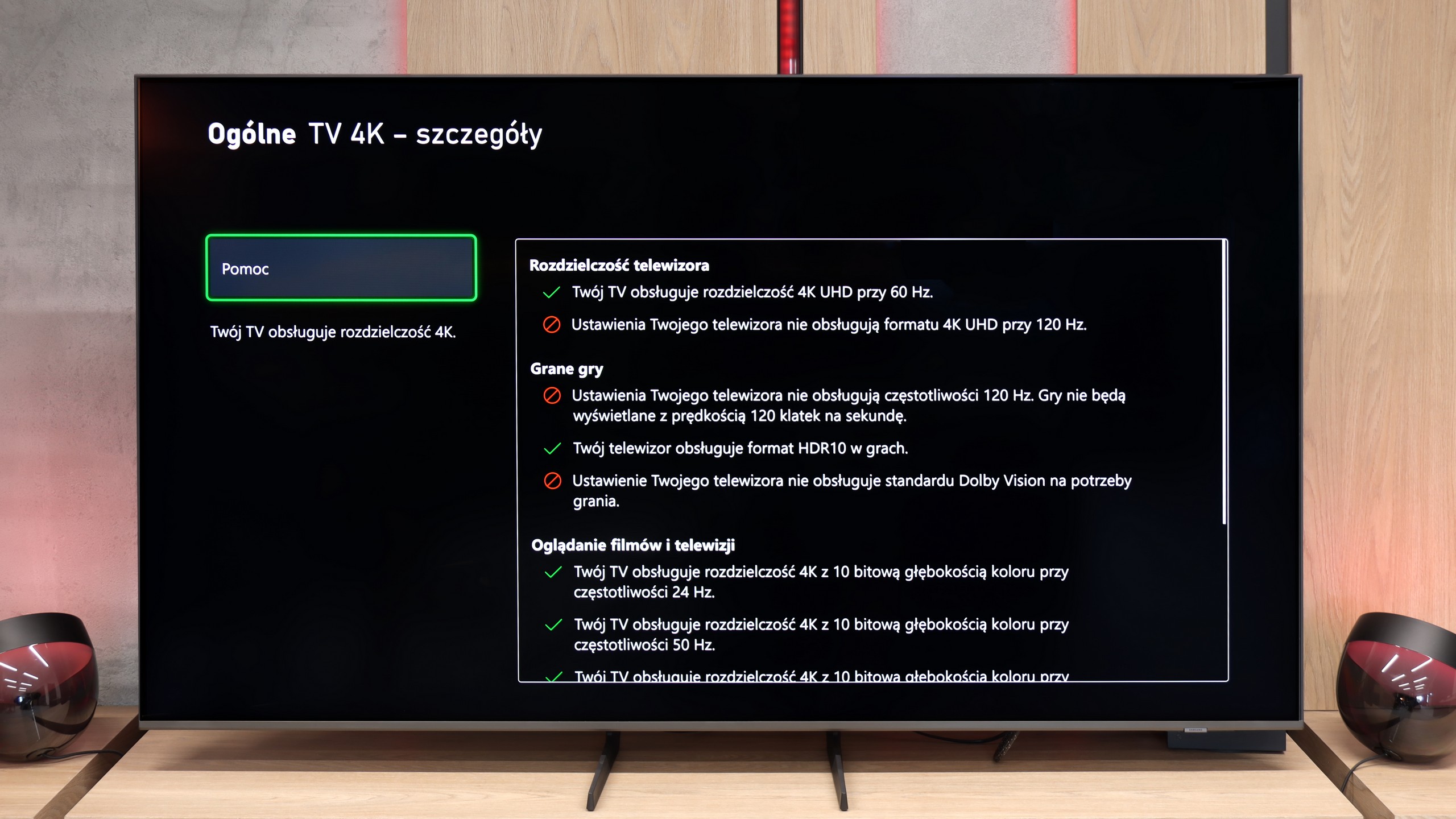
It's not entirely clear what Samsung has messed up this year with its TVs, but the Q8F isn't free from all the confusion with updates and shortcomings. While its older cousin, the Q67D, could still be recommended with a clear conscience to casual gamers, it's hard to find a reason to do so here. Aside from the automatic game mode and the attractively designed Game Bar, we get practically nothing that could appeal to gamers. The lack of proper HGiG implementation is a major issue, especially since the feature simply disappeared after the 1126 update. The situation with VRR is even worse. Even though it appears in the manufacturer's brochures and shows up in the Game Bar, we couldn't get it to work. The Xbox Series X console wouldn't allow it to be activated at all, and the option remained greyed out and inactive. It's difficult to praise such a TV even to casual gamers, which is a shame because Samsung has had a strong selling point in the gaming segment for years.
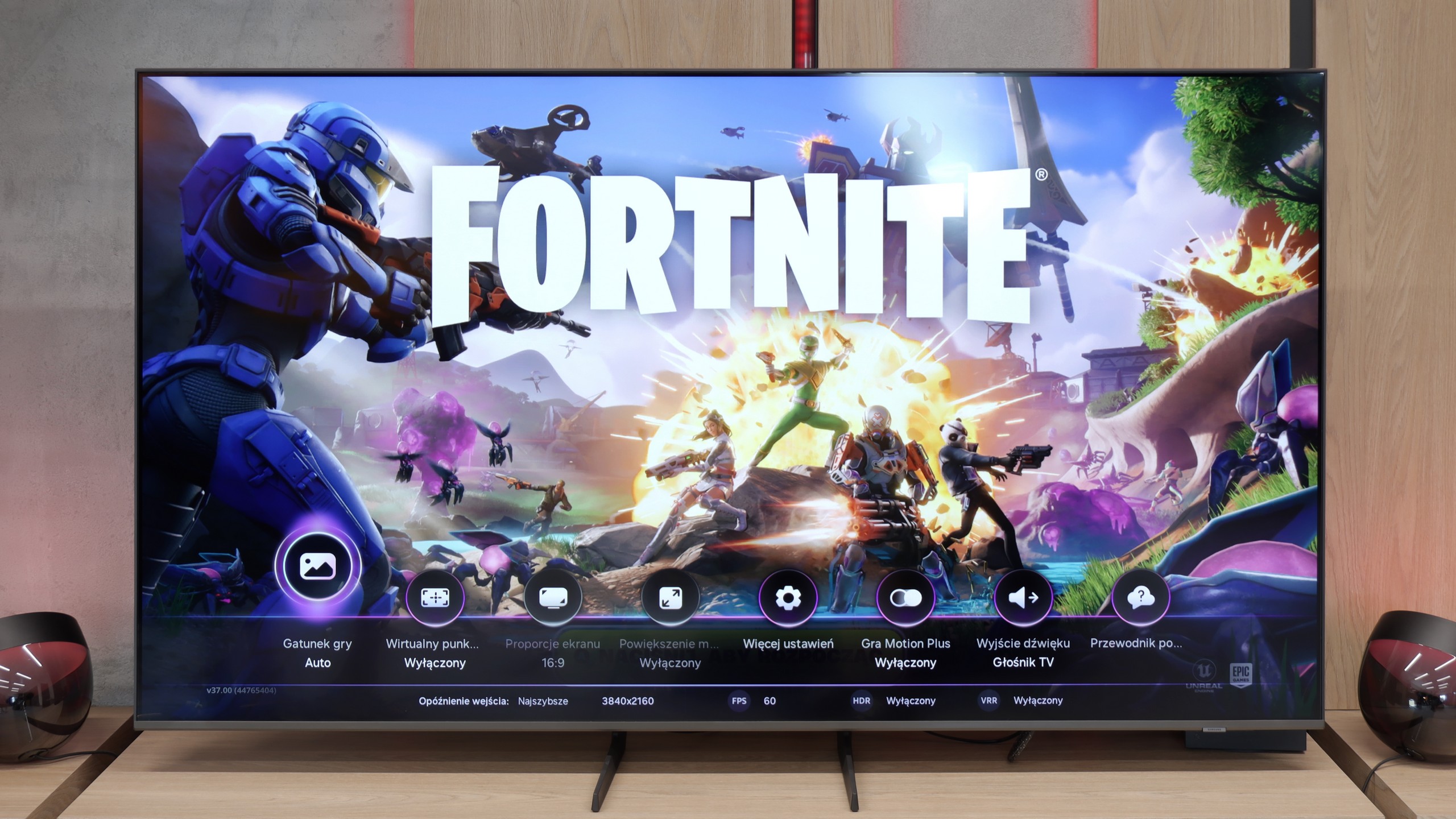
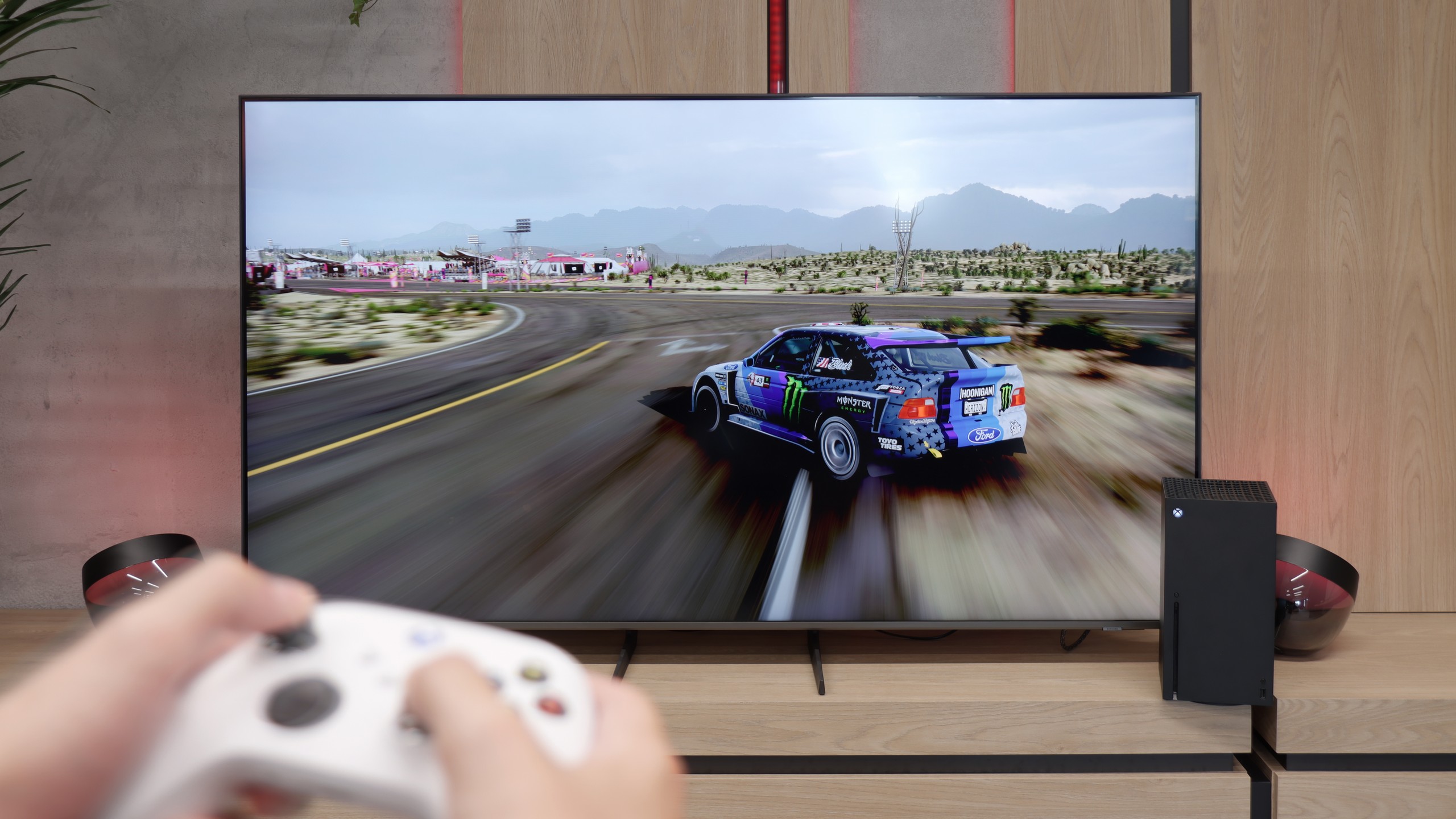

SAMSUNG Q8F - Input lag
9.9/10
Fortunately, when it comes to gaming, Samsung didn't try to "improve" anything and the input lag remained at an excellent level. Results hovering around 10–15 ms mean that the delays are practically unnoticeable. The controls are instant, and the responses from the console or computer appear on the screen without any noticeable delay. In this regard, the Q8F performs exceptionally well and it's hard to fault it.
| SDR | HDR | Dolby Vision |
|---|---|---|
| 1080p60: 14 ms | 2160p60: 12 ms | |
| 2160p60: 14 ms |

SAMSUNG Q8F - Compatibility with PC
6/10
Chroma 444 (maximum resolution and refresh rate): Yes
Font clarity: Very Good
Readability of dark text and shapes: Good
Input lag in PC mode (4K, maximum refresh rate): 14ms
Matrix subpixel arrangement: BGR
Max refresh rate: 60Hz
G-Sync: No
While playing on the Q8F isn't exactly the most attractive option—it's lacking modes with lower resolution and higher refresh rates, plus there are issues with VRR (G-Sync) and the panel is limited to 60 Hz—it performs excellently as a monitor for work. Font readability is at a very high level, so working with text or spreadsheets in Excel is a pure pleasure. In this regard, the Q8F could be a viable alternative to a large office monitor.
SAMSUNG Q8F - Viewing angles
3.4/10
Brightness drop at an angle of 45 degrees: 79%
The viewing angles on the Q8F can be described as average, resulting from the applied VA matrix. Watching the television head-on, the picture looks very good, but just shifting slightly to the side causes it to start fading and losing contrast. Colours gradually lose their saturation, and black takes on a greyish hue. This is a typical limitation of this type of panel, and it’s hard to expect miracles here. Compared to IPS matrices, the difference is clear — while these have weaker contrast, they hold colour better at an angle. The Q8F is best suited for a classic setup, where viewers sit centrally in front of the screen. If you’re planning screenings with a larger group, with people spread wider across the living room, the effect may not be as satisfying.
SAMSUNG Q8F - TV efficiency during daytime
5.6/10
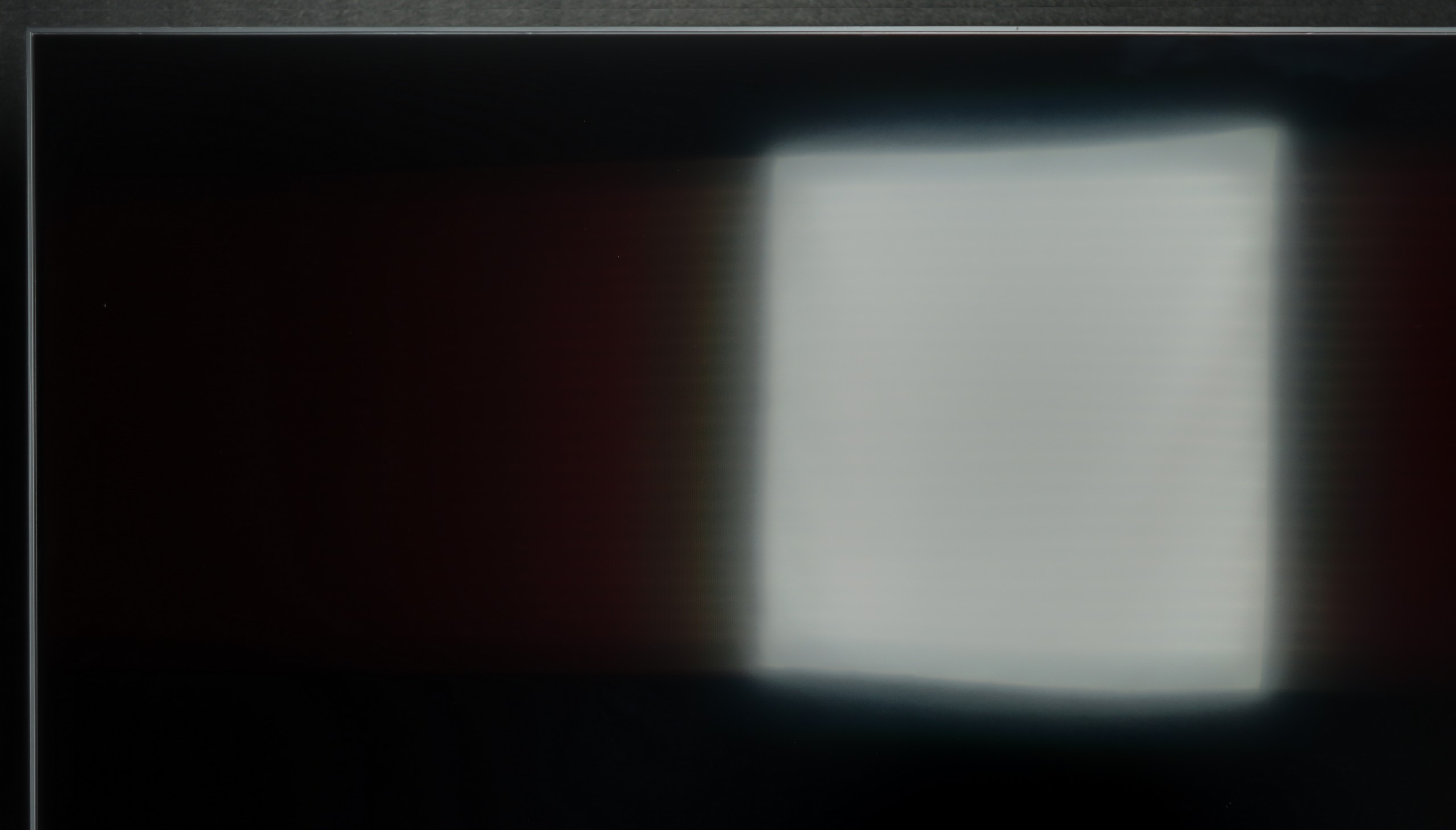
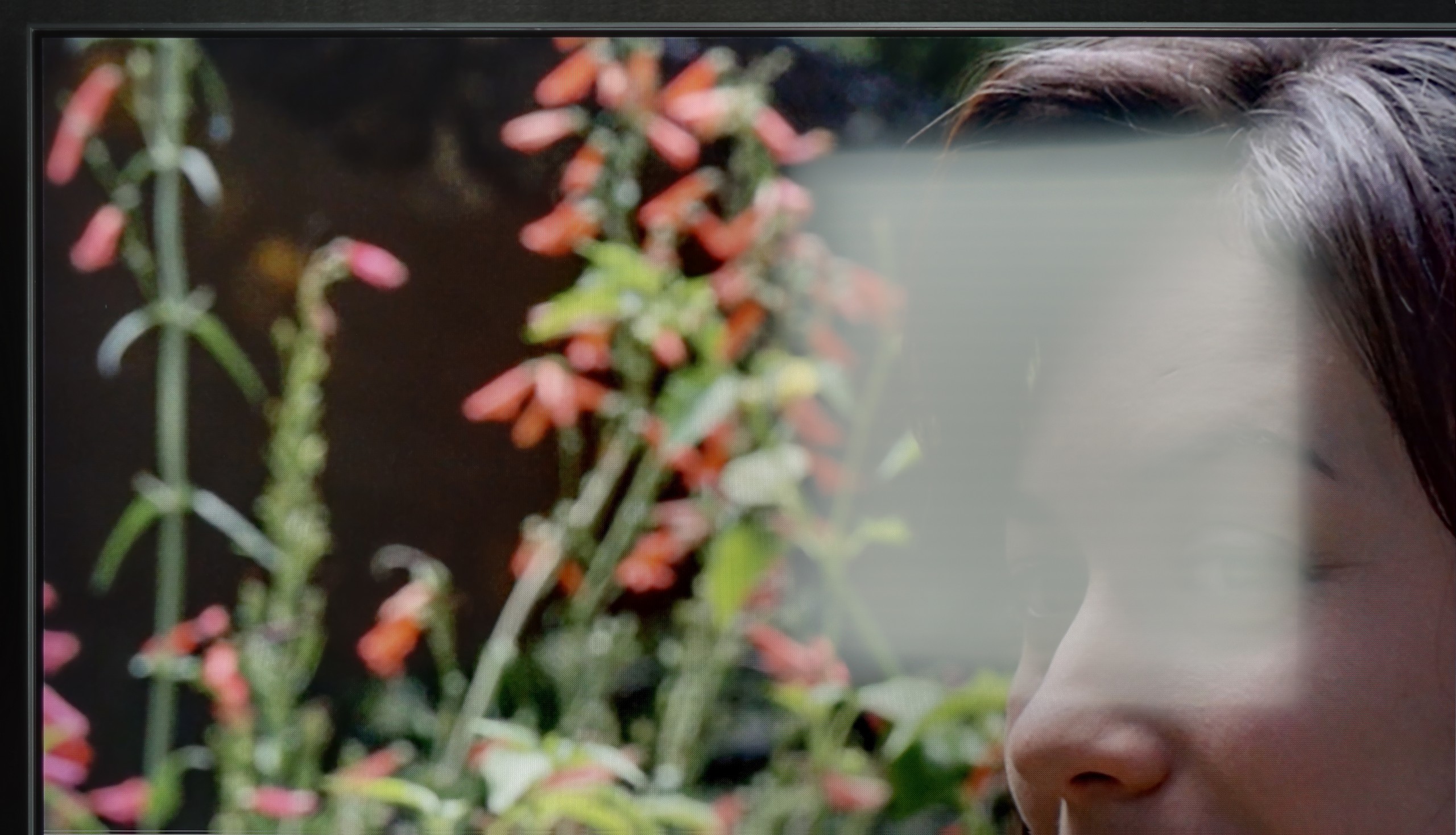
Matrix coating: Satin
Reflection suppression: Good
Black levels during daytime: Good
The Q8F performs quite well during the day. Its brightness hovers around 450 nits, which proves to be a sufficient level for moderately bright living rooms. It's not a TV that will win a battle against sunlight streaming directly through the window, but in typical home conditions, the picture remains clear and appealing. A big plus is the satin finish of the panel, which effectively reduces light reflections and helps maintain colour saturation even when the room is bright. This makes watching series during the day or evening sports broadcasts with the lights on no problem. The Q8F doesn't aspire to be a cinema TV in full sunlight, but as a daily screen in normal home conditions, it performs really well.
Matrix brightness
Average luminance SDR
Samsung Q8F: 430 cd/m2
SAMSUNG Q8F - TV features
7.3/10
System: Tizen
System performance: Good
- HDMI inputs: 3 x HDMI 2.0, 0 x HDMI 2.1
- Outputs: Toslink (Optical audio), eARC (HDMI), ARC (HDMI)
- Network Interfaces: Wi-Fi 2.4GHz, Wi-Fi 5GHz, Ethernet (LAN) 100Mbps
- TV reception: DVB-T, DVB-T2, DVB-S, DVB-S2, DVB-C
Classic features:
Recording to USB (terrestrial TV): No
Recording programming: No
Picture in Picture (PiP): No
RF remote control (no need to aim at the screen): RF
Backlit remote control: No
Teletext: Yes
Audio only mode: Yes
Bluetooth headphones support: Yes
Simultaneous Bluetooth headphones & TV audio: Yes
Smart features:
AirPlay: Yes
Screen mirroring (Windows Miracast): Yes
Voice search: Yes
Voice search in native language: Yes
Ability to connect a keyboard and mouse: Yes








SmartTV Features: Tizen
In terms of smart features, the Q8F is right up there with what Samsung has made us accustomed to. It comes with the Tizen system – fast, intuitive, and well integrated with other devices. AirPlay, screen mirroring, and simple voice commands work seamlessly, so the basics are ticked off perfectly. Added to this is SmartThings, an app that turns the TV into the hub of a home ecosystem. You can connect a washing machine, vacuum cleaner, light bulbs, or speakers and control everything from one place, including the TV. There are also plenty of apps in Tizen for watching movies and series – Netflix, YouTube, Disney+, and Prime Video are all readily available. However, it should be noted that Tizen is a closed system, so if someone is hoping to install less popular programs, they might be disappointed.
Traditional Television
Traditional television falls short. The Q8F simply serves as a screen here – it will display the picture, but additional features like USB recording or PiP mode are absent. The remote is small and very minimalist. It looks modern and can be charged via solar batteries on the back cover or through USB-C, but it's worth noting that it might not suit everyone – particularly older users may miss traditional buttons. However, it's fair to say that Samsung has been consistently steering its TVs (and competitors who are copying some of their ideas) towards the smart home direction rather than towards devices "for grandma and grandpa". Given the enormous popularity of the brand, one can assume that most users, even the older ones, have already gotten used to the fact that the era of remotes with a whole range of rubber buttons is slowly coming to an end.
Sound connection options
HDMI audio:
Other audio outputs:
Toslink: Yes
Wireless audio:
Bluetooth: Yes
Samsung Q-Symphony (Speaker extension): Yes
Obsługiwane formaty audio:
Dolby Digital Plus 7.1: Yes
Dolby True HD 7.1: No
Dolby Atmos in Dolby Digital Plus (JOC): No
Dolby Atmos in Dolby True HD: No
DTS:X in DTS-HD MA: No
DTS-HD Master Audio: No
Ułatwienia dla seniorów
Numeric keyboard on TV: No
Font size adjustment: Yes
Audio description: Yes
SAMSUNG Q8F - Apps
8.7/10























SAMSUNG Q8F - Playing files from USB
9.1/10

| Maximum photo resolution: | Supported photo formats: |
|---|---|
Samsung Q8F handles playback of files from USB quite efficiently. It supports almost all popular video formats as well as photos, so you can easily load a holiday movie or a family album. There are occasional exceptions with less popular photo formats, but the essential JPEG works flawlessly, which will be crucial for most users. It's a shame that Tizen doesn't allow the installation of alternative players, such as VLC. Then even less popular formats wouldn't pose any problem.
SAMSUNG Q8F - Sound
6/10
84dB
Maximum volume
Supported codecs
(TV speakers)
Dolby Digital Plus 7.1
Dolby True HD 7.1
Dolby Atmos in Dolby Digital Plus (JOC)
Dolby Atmos in Dolby True HD
DTS:X in DTS-HD MA
DTS-HD Master Audio
The sound on the Q8F can be described as acceptable. You can hear a slightly defined bass, but it's really minimal – the slim design of the television simply doesn't allow the pair of 2 × 10 W speakers to spread their wings. This is a typical scenario for most televisions: if someone cares about truly cinematic experiences, it's worth considering a soundbar. Samsung has a really wide range in this category across different budgets, so it's easy to find something suitable. The television itself is fine for watching traditional TV and series occasionally, but you wouldn't expect much in terms of audio excitement.
Acoustic Measurements
84dBC (Max)
75dBC
SAMSUNG Q8F - Details about the matrix
Software version during testing: T-RSLFDEUC-0090-1126.0, E2540300, BT-S
Subpixel Structure:
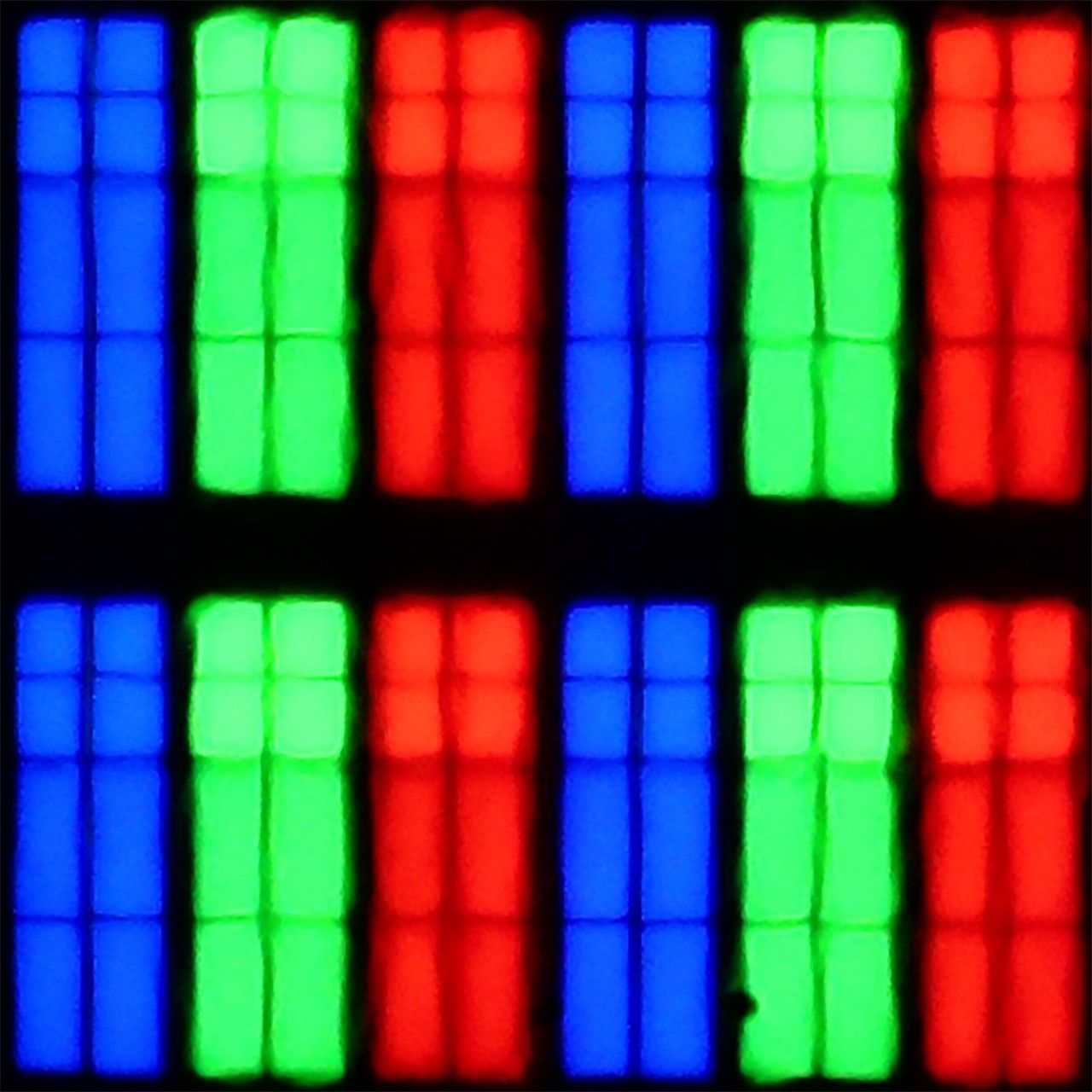
Panel uniformity and thermal imaging:
Backlight Type: QLED

Founder and originator of the "ChooseTV" portal

Journalist, reviewer, and columnist for the "ChooseTV" portal
See articles related to Samsung Q8F:
Shopping Reviews
The best Samsung TVs 2024 / 2025! Which Samsung television t... 4/30/2025
4/3/2025
Our channel Youtube
Smart calibration of Samsung TV in SmartThings 6/23/2025
8/13/2025
4/3/2025
